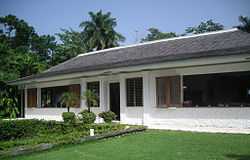Jalousie window


A jalousie window US /ˈdʒæləsiː/ or louvre window (Australia, New Zealand, Pacific Islands, Southeast Asia, UK) is a window which consists of parallel glass, acrylic, or wooden louvers set in a frame. The louvers are locked together onto a track, so that they may be tilted open and shut in unison, to control airflow through the window. They are usually controlled by a crank mechanism.
A patent for a louvered window was applied for in the US in 1900 and patented Nov. 26, 1901. Patent # 687705 by Joseph W. Walker, of Malden, Massachusetts.
Jalousie windows allow ventilation through the entire window area and are therefore generally used to maximise cooling, natural ventilation. They are well suited to locations with mild-winter climates, and thus were very common on mid-20th-century homes in Florida, Hawaii, southern California, the deep South, and Latin America. They can remain open during heavy rains and (because the glass louvers protrude outward) keep most of the rain from entering in through the windows. Old-style louvre windows do not achieve a good seal between panes so offer poor resistance to water penetration and drafts. It is also very hard to secure this design, as the slats are easily and silently removed.
They were also widely used in mobile homes during the 1950s and 1960s before most mobile home manufacturers began switching to sliding and sash windows in the 1970s and 1980s.
They are also called louver/slated/glass crankout windows in certain legal circles; jalousie windows with extremely wide louvered panels (e.g. over six inches) are frequently called awning windows.
Modern louvre windows are high performance, architectural windows that are commonly featured in award-winning Australian buildings.[1] Modern louvre windows are cyclone-rated, can be fitted with insect or security screens and have many customizing options.

See also
- Van Ellis Huff (1894–1987), has been widely credited as the inventor of the jalousie window, but no patents have been found in his name. He was only 6 years old when the first patent for the jalousie window was applied for by Joseph W. Walker (see above).
- Louver
- Window blind
References
- Martin, James (2007). Desserts. Quadrille Publishing. p. 71. ISBN 978-1-84400-463-8.
- Frasier, Dr. Henry S.; Hughes, Ronnie (2008). Historic Houses of Barbados. Wordsmith International. ISBN 978-976-95153-3-8.